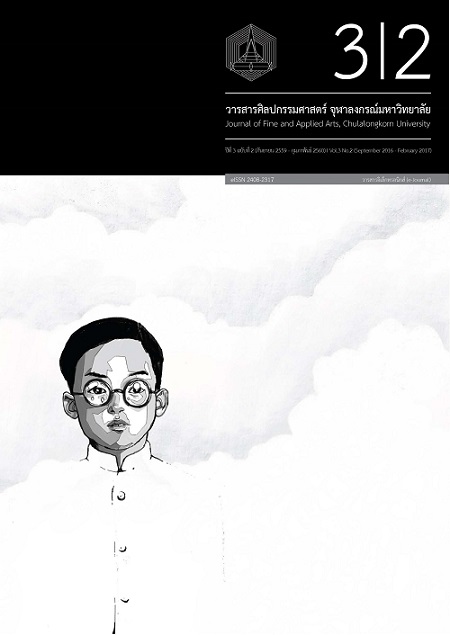รำสวดคณะครูสาคร ประจง อำเภอบ้านค่าย จังหวัดระยอง
Keywords:
รำสวด, สวดพระมาลัย, สวดคฤหัสถ์, การแสดงพื้นบ้านภาคตะวันออก, งานอวมงคล, คณะครูสาคร ประจงAbstract
บทคัดย่อ
รำสวดเป็นการแสดงพื้นบ้านที่พัฒนารูปแบบมาจากการสวดพระมาลัย และการสวดคฤหัสถ์ มีประวัติความเป็นมาตั้งแต่ครั้งสมัยกรุงศรีอยุธยา เป็นการแสดงพื้นบ้านที่มีความเกี่ยวข้องกับวิถีชีวิตของคนในจังหวัดระยอง ใช้แสดงเฉพาะงานอวมงคล มุ่งเน้นสร้างสรรค์อารมณ์ให้เจ้าภาพและผู้มาร่วมงานได้คลายความโศกเศร้า
การแสดงรำสวดคณะครูสาคร ประจง พบว่าเป็นคณะเดียวในอำเภอบ้านค่ายที่มีการสืบทอดและรับงานแสดงจนถึงปัจจุบัน รำสวดมีเอกลักษณ์ที่โดดเด่นคือ การนำบทสวดกับบทร้องในวรรณคดีหรือบทร้องที่ประพันธ์ขึ้นใหม่มาใส่เป็นทำนองให้มีสีสันในการร้อง ผนวกกับใส่เครื่องดนตรีกำกับจังหวะได้แก่ โทน ฉิ่ง กรับมากกว่า 2 คู่ เพิ่มอารมณ์ในการแสดงรำสวดมีความสนุกสนานมากยิ่งขึ้น ทำนองที่นำมาใช้ในการร้องรำสวดเป็นทำนองที่มาจากเพลงไทย การตัดทำนองให้สั้นลงและเปลี่ยนบันไดเสียงของทำนองเพลงและตัดบทร้องในวรรณคดีโดยการแทรกภาษาท้องถิ่นในบางคำเพื่อให้เหมาะสมกับนักร้องในวงดนตรีรำสวด มีวิธีการร่ายรำตีท่าทางไปตามบทร้อง ผู้รำต้องสามารถร้องและรำไปด้วย กระสวนจังหวะพบทั้งหมด 38 กระสวนสามารถจำแนกได้ 3 ประเภท ประเภทที่ 1 กระสวนที่พบมากที่สุดมีลักษณะกระสวนลงตรงตามจังหวะ พบการใช้ในการขึ้นต้นเพลงกลางเพลงและลงจบเพลง ประเภทที่ 2 กระสวนทั่วไป มีลักษณะกระสวนลงตรงตามจังหวะ ลักจังหวะ และกระสวนเว้นว่าง ประเภทที่ 3 กระสวนที่พบน้อยที่สุดมีลักษณะกระสวนลงตรงตามจังหวะและลักจังหวะ
Abstract
The Rum Suad or the Chanting Dance is a folk performance that was developed from the Phra Malai Chanting or the Kharuehat Chanting, which dates back to the Ayutthaya Period. This folk performance is related to the way of life of people in Rayong Province. It is strictly performed at times of unfortunate events with the aim of granting the hosts and guests relief from grief, much like a dirge.
The research has found that the Khru Sakhorn Prachong Dance Troupe is the only troupe in Ban Khai District that has perpetuated this kind of folk performance. The unique characteristic of this kind of chanting dance is that the chanting texts, the songs taken from literature and the newly composed songs are put to new melodies to make the chanting more colourful and are accompanied by more than two sets of musical instruments that control the chanting rhythm-one-faced drums, cymbals and wooden clappers, which make the performance livelier. The melodies of the chanting are from Thai songs which have been abbreviated and their musical scales changed. Some of the lyrics taken from literature are deleted and replaced by dialects that make them more appropriate for singers in a chanting dance troupe. The dance movements are created in accordance with the songs and the performers must sing and dance simultaneously. The research has discovered 38 rhythmic patterns, which can be classified into 3 types. The first type, which is most frequent, is a rhythmic pattern whose rhythms stress regular beats. This pattern is used at the beginning, in the middle and at the end of a song. The second type is a general rhythmic pattern whose rhythms stress irregular beats. The third type—the omitted rhythmic pattern, which is the least employed, is a combination of the first rhythmic pattern and the second rhythmic pattern.
Downloads
Additional Files
Published
Issue
Section
License
ลิขสิทธิ์ของบทความเป็นของเจ้าของบทความ บทความที่ได้รับการตีพิมพ์ถือเป็นทัศนะของผู้เขียน
กองบรรณาธิการไม่จำเป็นต้องเห็นด้วยและไม่รับผิดชอบต่อบทความนั้น






